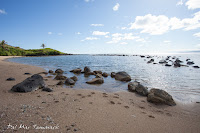 |
| Ancient fish pond |
 |
| Looking down at Halawa Valley |
Molokai is known as the Friendly Isle, and for its large population of native Hawaiians. It is a place of no chain restaurants, high rises, or stop lights. Ancient fish ponds dot the coastline, tucked in behind the largest barrier reef in Hawaii. If one follows the state highway until it dead ends at the Northeast corner of the island you will find a hidden world of ancient Hawaii hiding away from the hustle of the rest of the state. This hidden gem is called Halawa Valley.
 |
| Uncle Polipo |
 |
| Greg blowing the Pu |
Halawa Valley is blessed with copious rain, a protected bay, an idyllic stream, and up to nine waterfalls cascading down the back of the valley. The valley was once a bustling farming community, but this all changed when a tsunami washed 1.7 miles up the valley on April 1st, 1946. It is moving hearing the story of that fateful day from someone who was there, watching and listening to the destruction from the hillside. Philip Solitario is the oldest living descendent born and raised in the valley who is still living in the valley. Tears well up in his eyes as he recounts that story, but it is only one of many stories that he holds and shares about this valley that his family has called home for 50 generations.
 |
| Welcome chant to Halawa |
Today Philip, who everyone refers to as Uncle Polipo or simply "Pops", is the cultural practitioner of the valley. He and his son Greg teach visitors and Hawaiians alike the ways of their anscestors. Switching out modern day cell phones for traditional 'shell'-phones, Uncle Polipo and Greg blow the Pu, or conch to begin the ancient protocol of asking permission to enter the valley. The sound of the shell echoes off the steep walls of the valley and immediately takes you back to a time long past.
 |
| Greg and Pops doing the Honi |

After the Oli chant and giving of gifts, we all participate in the traditional Hawaiian greeting called the 'Honi.' It means 'to kiss' in Hawaiian but it involves no lips. The honi is done by pressing your forehead and nose together and breathing in. Through this process it is believed that you share "Ha", the breath of life and are no longer strangers.
 |
| Where the stream meets the ocean |
 |
| Halawa bay and beach |
I've learned a great many things from Pops and Greg that transcend all cultures and religions. One of these lessons is known in Hawaiian as 'Nana ike Kumu.' This means 'Go to the Source.' In Halawa valley this means learning about your history and where you come from by learning from your elders...not books written by outsiders. Elders are their most prized possessions for the knowledge they hold. Luckily Greg believe firmly in this and made the decision to move back to the valley from Oahu to continue the legacy and learn all he can from his dad before he is gone.
 |
| Pops, Me, and Greg |
The Solitario family believes the Hawaiian culture should be sacred, not secret, which is quite lucky for us who want to soak up and learn more about the real Hawaii. It has been amazing visiting this beautiful place over the last four years. I have grown close to Pops and Greg and hope I continue to see them thrive in the future. I really admire what they are doing and have been glad to expose so many people to this through these UnCruise Hawaii trips.






 After the Oli chant and giving of gifts, we all participate in the traditional Hawaiian greeting called the 'Honi.' It means 'to kiss' in Hawaiian but it involves no lips. The honi is done by pressing your forehead and nose together and breathing in. Through this process it is believed that you share "Ha", the breath of life and are no longer strangers.
After the Oli chant and giving of gifts, we all participate in the traditional Hawaiian greeting called the 'Honi.' It means 'to kiss' in Hawaiian but it involves no lips. The honi is done by pressing your forehead and nose together and breathing in. Through this process it is believed that you share "Ha", the breath of life and are no longer strangers.







Comments
Post a Comment
Leaving a comment is a great way to provide feedback, ask further questions, and inspire more answers...so go for it.